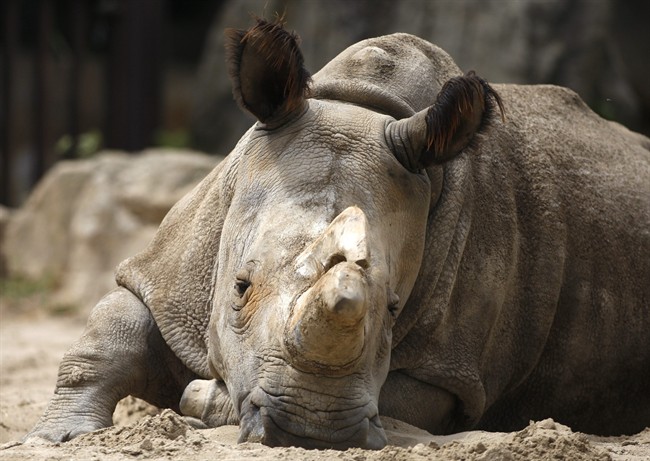DVUR KRALOVE, Czech Republic – She’s the last northern white rhinoceros on view anywhere in Europe – but zoo keepers are hoping lonely Nabire will find solace with a southern rhino 11 years her senior.

Another northern white – Nesari – died here in her sleep in May aged 39, further reducing the world’s dwindling population of the critically endangered animal.
“Of course, Nabire is missing her,” said Jiri Hruby, the curator of mammals at the zoo in Dvur Kralove, about 120 kilometres (75 miles) northeast of Prague. “We try to do the maximum we can for her. We pamper her.”
To help her cope with the loss of Nesari, keepers have decided to team up 27-year-old Nabire with a new partner, 38-year-old male Natal. Natal is a southern white, another rhino subspecies.
On Friday, they were seen snuggling, lazing in the sun and eating and sleeping in their enclosure.
“It is really friendly. There’s no signs of any antagonism between them, they don’t fight for position,” said Pavel Moucha, head zoologist at the zoo.
Previously, they were kept apart because Nabire had an ankle inflammation which would have worsened if the two had tried to mate. She stood alone in an enclosure, accepting morsels of bread.
Even if the two prove a match, it won’t be possible for Nabire to breed because of “pathological changes to her breeding organs,” Hruby said.
With rhino horns considered a cure for everything from colds and fevers to high blood pressure, impotence and other ailments, poachers have decimated rhino populations in Africa and elsewhere.
The northern white rhino is the most highly endangered mega-vertebrate on earth. Southern white rhinos almost went extinct at the end of the 19th century, plunging down to only 20 at one point. Decades of conservation efforts gradually brought them back to life. Northern whites are now in critical danger and only seven live in captivity – two of them at San Diego Wild Animal Park.
Several others may have survived in Sudan in the wild, Hruby said, but he acknowledges that’s only “theoretical.”
In 2009, the Dvur Kralove zoo transported its other four northern white rhinos to the Ol Pejeta Conservancy in Kenya where experts hope the mammals will reproduce. Nabire and Nesari were not part of the move because of health problems.
White rhinos are the biggest of the rhino family, weighing as much as 6,000 pounds (about 2,700 kilograms). Among land mammals, only the elephant is bigger.
The Czech zoo has a history of taking care of white rhinos dating back to the mid-1970s when the first of them, two male and four female, arrived from Africa.
Four white rhinos have been born in the zoo since then – but the last birth was in 2000. The others were sent back to their savannah habitat in Africa, because “that’s all we could do to save them,” Hruby said.
Rhino horns sell for more than gold on a per-weight basis. The northern whites traditionally roamed in the Democratic Republic of Congo, Sudan and Uganda.




Comments